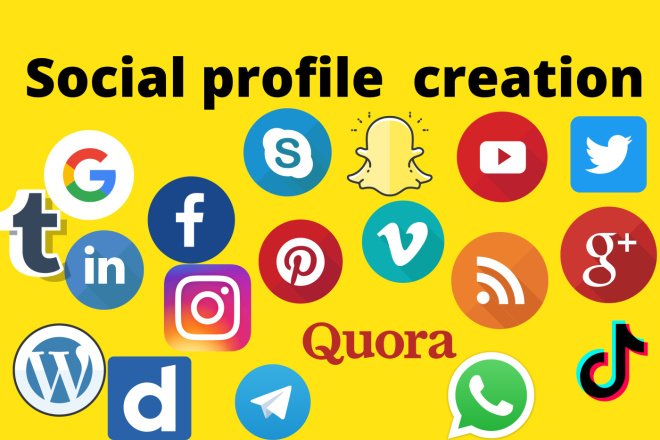Creating and optimizing your social media profiles is a vital step in building a strong online presence for your business or brand. Well-crafted social profiles help you connect with your audience, build trust, and drive traffic to your website. Below is a step-by-step guide for creating and optimizing your social media profiles:
1. Choose the Right Social Platforms
Not all social media platforms may be relevant for your business. Focus on the platforms that best align with your target audience and business goals:
- Facebook: Great for businesses targeting a broad demographic, including local businesses and e-commerce.
- Instagram: Ideal for visually-driven industries (e.g., fashion, interior design, food).
- LinkedIn: Best for B2B businesses, networking, and establishing thought leadership.
- Twitter: Useful for real-time updates, customer engagement, and joining industry conversations.
- Pinterest: Great for businesses in lifestyle, fashion, home décor, and food industries.
- TikTok: Popular for creative, short-form video content, especially for younger audiences.
- YouTube: Ideal for businesses that produce video content or tutorials.
2. Create a Strong Profile Picture
Your profile picture should reflect your brand identity and be clear across all platforms.
- Branding: Use your logo for consistency, especially for businesses.
- Clarity: Ensure the image is high-quality and easily identifiable.
- Appropriateness: Make sure the profile image aligns with the platform’s purpose (e.g., a professional photo on LinkedIn and a casual, engaging image on Instagram).
3. Write a Compelling Bio/Description
The bio or description is one of the first things people will see. Make it concise, engaging, and informative.
- Keep it concise: Most platforms have character limits for bios. Stick to the essentials while keeping it impactful.
- Include Keywords: Use relevant keywords for SEO purposes, helping people find your profile.
- Call to Action (CTA): Include a CTA (e.g., “Visit our website,” “Shop now,” “Follow for updates”).
- Consistency: Ensure your brand voice and messaging are consistent across all profiles.
4. Add Contact Information and Links
Make it easy for your audience to reach you.
- Email: Always include a contact email for inquiries.
- Phone Number: If applicable, add a business phone number.
- Website Link: Include your website or landing page link.
- Social Links: Add links to other social media profiles to cross-promote.
5. Customize Profile and Cover Images
Your profile and cover images (for platforms like Facebook and LinkedIn) should represent your business visually.
- Cover Image: Choose a visually appealing cover image that aligns with your brand, product, or current campaigns. It’s often the first thing people see.
- Profile Image Size: Ensure your profile image meets platform specifications (e.g., 180×180 pixels on Instagram, 400×400 pixels on LinkedIn).
- Cover Image Size: Ensure cover images are the correct size for each platform (e.g., 820×312 pixels on Facebook).
6. Fill Out All Profile Fields
Platforms offer various fields to help you describe your business. Fill them all out to ensure your profile is complete:
- Business Category: Choose the appropriate category (e.g., Interior Design, Digital Marketing, E-commerce).
- Location: Include a location if your business is location-specific.
- Hours of Operation: If applicable, list your business hours.
- Additional Information: Some platforms like LinkedIn allow you to add specialties, services, or a company overview.
7. Set Up Your Content Strategy
Now that your profiles are set up, think about the type of content you’ll share.
- Consistency: Maintain a consistent posting schedule to keep your audience engaged.
- Content Mix: Use a mix of content types, such as images, videos, blog posts, infographics, and behind-the-scenes content.
- Brand Voice: Ensure that all your content aligns with your brand voice and messaging.
8. Enable Social Media Integrations
Integrate your social profiles with your website or other digital platforms:
- Social Media Buttons: Add social media buttons to your website so visitors can easily find your profiles.
- Social Media Widgets: Add social media widgets or feeds to display your latest posts on your website.
- Third-Party Tools: Consider using social media management tools like Hootsuite, Buffer, or Sprout Social to schedule posts, track analytics, and engage with your audience.
9. Verify Your Profile
To increase trust and credibility, verify your social profiles when possible.
- Blue Check (Verification Badge): Some platforms, such as Twitter and Instagram, offer verification badges for businesses and public figures. Apply for verification if applicable.
- Email Confirmation: Most platforms will ask you to verify your email address before your profile is fully functional.
10. Start Engaging with Your Audience
Once your profile is complete, focus on building relationships and growing your following.
- Respond to Comments and Messages: Engage with followers by replying to their comments and messages.
- Follow Others: Follow relevant accounts and interact with them (e.g., liking posts, commenting, sharing content).
- Promote User-Generated Content (UGC): Encourage followers to create content about your brand and share it.
Social Media Profile Creation Checklist
- Choose the right platforms for your business.
- Upload a high-quality, consistent profile image.
- Write an engaging, keyword-optimized bio.
- Add contact details and links to your website or landing page.
- Customize your profile and cover images.
- Fill out all necessary fields (e.g., business category, location).
- Set up a content strategy with a posting schedule.
- Integrate social media with your website.
- Verify your profile when possible.
- Start engaging with your audience and building relationships.
Tips for Optimizing Your Social Profiles
- Use a consistent username: Ensure your username/handle is consistent across platforms for brand recognition.
- Monitor performance: Use platform analytics to track engagement and adjust your strategy accordingly.
- Update regularly: Update your profile information and content regularly to stay current.
- Run promotions: Use social media to run giveaways or promotions to increase engagement and attract followers.
By following these steps, you’ll have optimized social media profiles that help you attract and engage with your audience effectively. Let me know if you need specific advice on setting up a profile for a particular platform or any additional tips!



